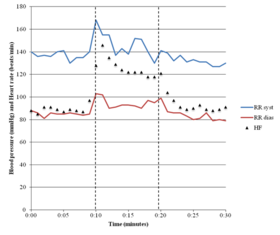This article needs additional citations for verification. (February 2015) |
| Tilt table test | |
|---|---|
 Results of a tilt table test in a person with POTS | |
| MeSH | D018667 |
A tilt table test (TTT), occasionally called upright tilt testing (UTT), is a medical procedure often used to diagnose dysautonomia or syncope. Patients with symptoms of dizziness or lightheadedness, with or without a loss of consciousness (fainting), suspected to be associated with a drop in blood pressure or positional tachycardia are good candidates for this test.
The procedure tests for causes of syncope by attempting to cause syncope by having the patient lie flat on a special table or bed and then be monitored with ECG and a blood pressure monitor that measure continuous, beat to beat, non-invasively. The table then creates a change in posture from lying to standing.